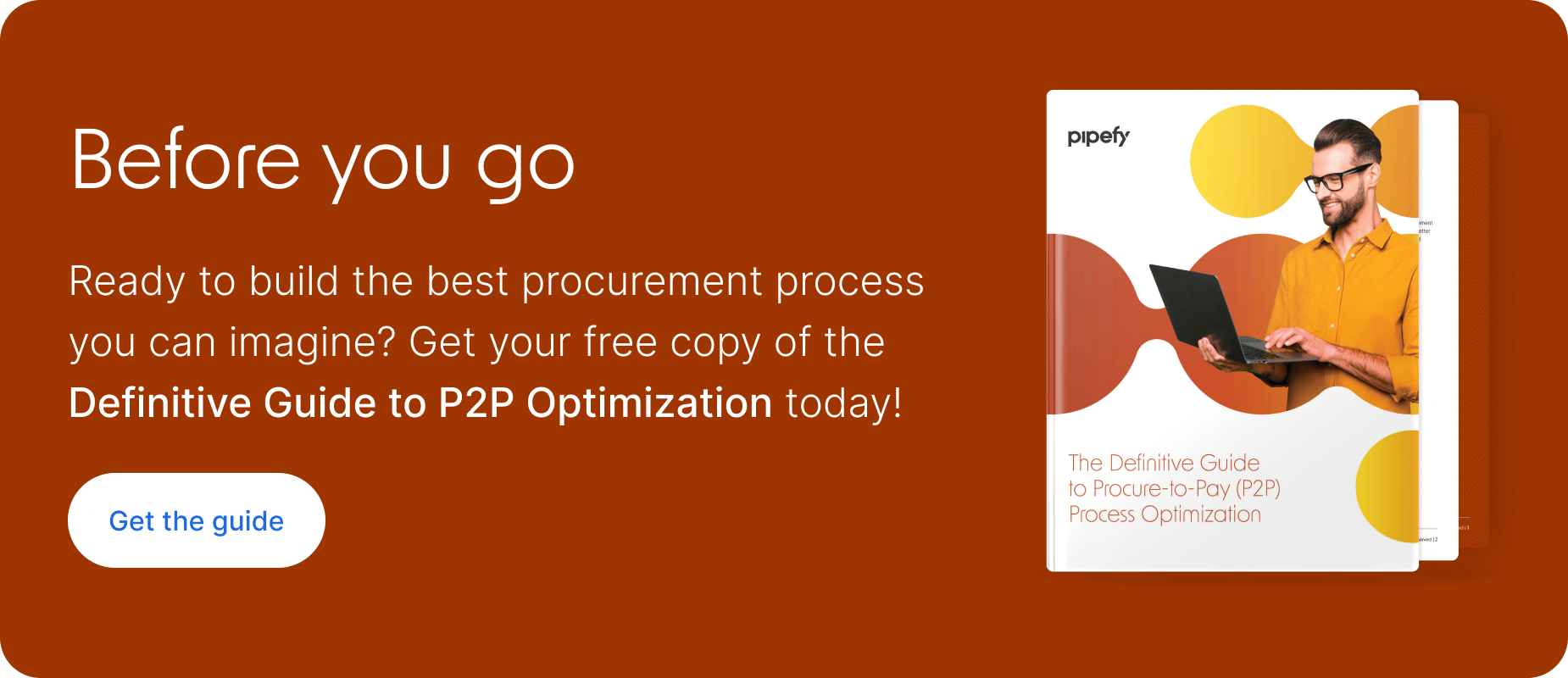
The need for efficient and error-proof procurement processes has never been greater. Following recent unprecedented events and disruptions, one thing has become clear: procurement optimization is no longer just about cost-effectiveness or efficiency.
In order to prepare for the next great disruption, a total overhaul of processes through procurement transformation is required to unlock a business that will not only survive but thrive as well. In this post, we’ll explore what procurement transformation is, why it’s needed, and how it can help procurement teams meet changing needs and manage ever-evolving processes.
Definitive Guide to P2P OptimizationDownload now
What is procurement transformation?
Procurement transformation, or digital procurement transformation, refers to the evolution of procurement from a tactical-focused function to a more strategic and business-focused function. This shift has become necessary as procurement departments are tasked by management with new strategic duties.
Procurement teams are now responsible for driving value, achieving sustainable results, and helping businesses maintain their competitive edge despite market shifts and supply chain disruptions.
What is a procurement transformation roadmap?
A procurement transformation roadmap serves as a detailed brief of steps, timelines, risk planning, communication and collaboration needs or changes, and resources — whether it’s people or technology — that are required to achieve procurement transformation and sell the final vision to key stakeholders, such as leaders and procurement teams.
What is a procurement transformation strategy?
A procurement strategy creates a sustainable and agile plan for improving procurement processes, increasing procurement efficiency, building better supplier relationships, and generating additional long-term cost savings for the business.
4 trends that make procurement transformation essential
1. A profound break in how procurement teams work
The greatest post-pandemic shift that’s occurred in the post-pandemic business world is the way teams work. As more teams adopt a remote-first approach, the manual and analog processes of yesteryear no longer work in today’s new state of collaboration.
Learn how Ocean Network Express overcame this challenge and created a clear channel of communication between departments and accounts payable systems with Pipefy.
2. A shift in business demands and the role of procurement
Due to the new business landscape, procurement teams no longer just seek to save companies money or operate a tactical department. Procurement teams are now expected to perform as a strategic, value-creating business partner that improves business agility, financial visibility, process resilience, and competitiveness.
3. An abundance of manual work and rapidly changing processes
In 2022, the five biggest procurement issues experienced by B2B buyers were:
- Reliable delivery (43%)
- Maintaining compliance of spend policies and dealing with rouge spending (40%)
- Complex purchasing systems (31%)
- Complex approval processes (29%)
- Time-consuming invoice reconciliation (28%)
Many of these concerns are a result of complicated and disconnected procurement and finance processes and highlight the need to digitalize and automate purchasing and procure-to-pay processes with a software solution that offers management controls, automation, and data analytics for end-to-end supply chain and process data visibility.
4. A continuation of IT and developer shortages
This trend has been bubbling under the surface for a while and it’s finally reached a boiling point. Sixty-four percent of IT executives see the growing IT talent shortage — a shortage that’s expected to continue for the better part of the next decade — as the most relevant barrier to the adoption of emerging technologies. To make matters more complicated, IT talent retention is now also at risk.
This talent shortage and retention issue present an even larger concern for complex and ever-evolving procurement processes that require technical help to make optimizations or changes.
5. A necessity for sourcing transformation
Since early 2020, the spotlight has been on supply chains and supply chain management.
The spotlight only began to grow brighter (and hotter) as supply chain risks and vulnerabilities began to grow following layoffs, hiring freezes, shortages, and geopolitical conflict, instability, and war.
Another sourcing element that has shaken up supply chains is a lack of visibility into inventory and supply bases due in part to siloed and manually operated processes, disconnected departments, and a breakdown in communication between suppliers and internal teams.
In order to alleviate the pressure on supply chains and get ahead of any interruptions, procurement transformation is necessary for improving strategic sourcing, supplier management, and demand forecasting.
Learn more about strategic sourcing optimization.
Procurement transformation roadmap tutorial
To achieve procurement transformation, a complete overhaul of legacy processes and systems is required to replace them with more modern and agile processes and solutions. A roadmap is a great starting point to determine and define clear objectives and benefits, the resources that will be required, and the timeline for the transformation.
With this roadmap, companies are better equipped to address three key areas of improvement: people, processes, and technology. To help you build out your roadmap and transformation strategy, consider these questions for each of these procurement pillars.
Objectives
- What does the company or procurement department want to achieve?
- Why is this important or necessary?
Benefits
- What are the short-term and long-term benefits of procurement transformation for your procurement organization and business?
- What are the tangible and financial impact of these benefits for the business?
- How will other departments benefit from procurement transformation?
Resources
- What resources are required to achieve procurement transformation?
- What costs will be incurred?
- Is the existing procurement team staffed adequately to meet needs?
Timeline
- What is the timeline for the transformation?
- What will the execution look like? How will it be paced or structured?
- Are there any anticipated delays or bottlenecks?
- How will delays or bottlenecks be addressed if/when they occur?
People
- Which departments will be impacted by the transformation?
- Are there any skill or knowledge gaps that need to be addressed? If so, what is required to help upskill existing teams?
- How will changes be managed and shared with teams?
Processes
- Are there inefficiencies in existing processes? If so, what are they?
- How are these inefficiencies affecting the overall procurement performance?
- Can existing processes be optimized or salvaged, or do they require a complete overhaul?
- Are all required procurement processes included?
- How will process changes be managed and shared with teams?
Technology
- How is the existing tech stack performing?
- Are there any disconnects between the current technologies and applications that are impacting process efficiency or procurement department performance? Or, are there disconnects due to missing solutions, such as process automation, integrations, or robotic process automation?
- How will technology changes or additions be managed and shared with teams?
Once all the procurement pillars have been defined, it’s now time to sell the final (or end-state) vision to leaders. To successfully do this, it’s important to:
- Showcase the short- and long-term optimization benefits. Rather than saying “save money,” bring that benefit to life by painting a picture of what that would look like in the real world.
- Present the ROI. Add another layer to your benefits by identifying the financial impact. So if the goal is saving time or increasing productivity by investing in automation software, define what that means financially.
- Map the impact on organizational structures and systems. Change management is just as important as the changes themselves. Put any fears or hesitations to rest with a clear and detailed plan for how procurement transformation will impact the organization, who will be affected or which departments, and what the timeline is for the changes.
How to build a resilient procurement transformation strategy
Once you’re ready to start moving forward in your procurement transformation journey, here are three steps to improve your procurement strategy.
Evaluate the current roadmap
Today’s business and procurement needs may change more rapidly, so it’s best to remain flexible. After all, the roadmap that made sense six months ago may no longer make sense today. By evaluating your current procurement roadmap, you will have a clearer understanding of the current state of your procurement organization, what changes need to be made to the existing roadmap, and how to improve communication and collaboration with specific stakeholders.
During this step, consider whether the roadmap adequately meets and fulfills the needs of the following:
- Stakeholder and supplier engagement
- Timelines
- Problem resolutions
- Technology
- People
- Processes
This step is integral to not only achieving both procurement and business goals but ensuring that the procurement transformation strategy aligns with the procurement transformation roadmap.
Define the procurement strategy
A procurement strategy serves as a compass for paving your procurement transformation roadmap. Once you’ve evaluated the roadmap and determined that all the procurement pillars are pointed in the right direction and equipped to achieve short- and long-term goals, it’s time to define the strategy.
At this stage, consider the following questions:
- What is the strategic objective? What is the end-state goal?
- How are suppliers performing? What can be improved? How can it be improved?
- What resources (people, technology, processes) are required to bring the strategy to life?
- What are the KPIs for the strategy? How will they be measured? Who will be responsible for tracking, measuring, and reporting them?
- What innovations can be made that aren’t already accounted for?
- Is there a defined plan for rolling out this strategy and communicating it with relevant stakeholders? How will the strategy be communicated?
- Is the strategy aligned with larger business objectives or goals?
- Is the strategy equipped for real-time updates, or will changes be difficult to make? If the latter, how can the strategy be made more agile?
Learn more about how to develop and define your procurement strategy.
Align the procurement transformation roadmap and strategy
A roadmap is only as good as the compass that’s being used to navigate it. So if the procurement strategy isn’t clear or defined, the procurement transformation roadmap isn’t of much use. During this step, check for any gaps in the strategy or roadmap that need to be bridged.
For example, if the roadmap makes it clear when the transformation will be completed but the strategy lacks a defined approach for executing the transformation, then this is a gap that needs to be patched.
Unlock procurement transformation with process automation
Procurement transformation not only maximizes a team’s capacity to do the most with what they have, but it also maximizes competitiveness, business agility, and procurement process resilience. And with the right technology, this transformation can be achieved and designed to last.
A key part of procurement transformation is implementing new technologies and optimizing existing stacks to stop any potential value “leaks” and future-proof procurement processes to offset any future disruptions.
Business process automation (BPA) software is just one example of this type of technology. BPA software makes procurement transformation possible by streamlining, automating, and orchestrating complex and ever-evolving procurement processes.
Many of the BPA software options available today offer a visual user interface that makes it easy for procurement teams to take on technical work — like designing, optimizing, or automating processes or tasks — without any technical knowledge.
This layer of technology makes it easier to enforce supplier compliance requirements, simplify KPI reporting, improve process monitoring and forecasting, reduce errors and delays, extend the capabilities of existing apps (a feature known as stack extensibility), eliminate data or process silos that may interrupt or limit supporting procurement processes, like purchasing, source-to-pay, or procure-to-pay, and create better working relationships and communication with suppliers, stakeholders, and connected teams or departments.






